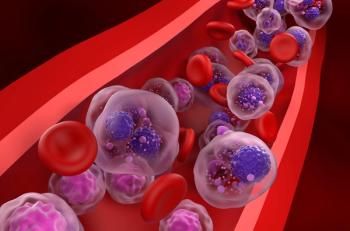
- January 2017 Oncology
- Volume 83
- Issue 1
The Oncology Pharmacist: Taking the Helm in Medication Management
Driven by the graying of America, more than 75% of all newly diagnosed cancers occur in people aged 55 or older. Oncology—and oncology pharmacists—are changing hats swiftly.
Driven by the graying of America, more than 75% of all newly diagnosed cancers occur in people aged 55 or older. Oncology—and oncology pharmacists—are changing hats swiftly.1
Traditional Roles
Traditionally, inpatient or outpatient oncology pharmacists checked and dispensed medication.1 This pivotal responsibility has since evolved. Pharmacists are progressively swapping their dispensing hats for clinical caps, thanks to technician assistance, technology advancements, and practice progression.1
Jon Jankun, RPh, of Hallmark Health, indicates that his institution uses a 3-tiered review process. Pharmacists review chemotherapy orders, monitor pertinent tests, and send recommendations to prescribers if necessary. These functions exploit oncology pharmacists’ specialized knowledge of antineoplastics and supportive care for comorbidities as some begin to work in remarkably progressive roles.
Jay Patel, PharmD, of Banner MD Anderson Cancer Center in Gilbert, Arizona, reports, “I work with oncologists to decide what chemother- apy regimens and supportive care are required for patients based on specific factors—organ function, age, cancer stage, etc—and the evidence in the literature.”
With more than 800 drugs, biologics, and vaccines in development for cancer, the “drug expert” label keeps oncology pharmacists learning constantly.3 In 2016 alone, the FDA approved or modified indications for 18 agents (online table 13), with some being subject to multiple actions. These ongoing developments create considerable formulary management responsibilities. For example, at Hallmark Health, oncology phar- macists are integral to the Oncology Pharmacy and Therapeutics (P&T) Committee. Like general P&T committees, this committee develops policies and procedures, periodically reassessing them. Pharmacists also present comprehensive information about new drugs proposed for possible formulary addition and evaluate ongoing uses of approved drugs.1
Expanding Patient Education
The unprecedented numbers of oncology agents approved in the past few years translate to complex, targeted therapy. Qualified oncology pharmacists who practice in this field have become a treatment team’s critical drug information source. Because drug interactions are a serious concern,1 Dr. Patel indicates that he often collaborates with providers. For example, prescribers will typically ask the oncology pharmacist if antibiotics will cover infections without precipitating interactions in these heavily medicated patients.
Only 65% of patients nationally reported receiving education about their medications, according to the 2015 Hospital Consumer Assessment of Healthcare Providers and Systems survey.4 This large void can lead to poor outcomes. Lisa Holle, PharmD, of the University of Connecticut’s Neag Comprehensive Cancer Center, works directly with oncologists to promote patient care involvement. A quick review of online table 1 shows that new agents have novel mechanisms and narrow indications and that these agents are often approved with companion diagnostic or monitoring kits.5 Many also have boxed warnings. Oncology pharmacists need to be prepared to deal with cancer treatment’s increased complexity and to help patients as they receive more combination therapies and progressive lines of therapy.6
Because cancer treatment increasingly relies on oral agents, Dr. Holle reminds us that patients sometimes carry their chemotherapy home, taking it without supervision. Therefore, Dr. Patel and Dr. Holle conduct medication therapy management (MTM) in the clinic and by phone. The intensive education delivered through MTM addresses drug interactions, food interactions, and adherence. This last item is especially important because missed doses could cause cancer recurrence or resistance. The results of a retrospective cohort study indicate that pharmacist monitoring contributes to suc- cessful treatment.7 Comparable studies (table 27-11) have produced similarly positive results.
End Note
Dr. Holle reports that lacking prescriptive authority, oncology pharmacists cannot bill for services independently as midlevel providers do. Currently, only pharmacists who execute collaborative practice agreements can see patients independently. Legislature is the only alternative solution to this challenge.1 Ongoing role expansion will rely on the accumulation of data that show that pharmacists improve individual systemic outcomes.
Mr. De Lena is a 2017 PharmD candidate at the University of Connecticut. Ms. Wick is a visiting professor at the University of Connecticut.
References:
- Hematology/Oncology Pharmacy Association. Scope of hematology/oncology pharmacy practice. HOPA website. hoparx.org/images/hopa/resource-library/professional-tools/HOPA13_ScopeofPracticeBk.pdf. Published 2013. Accessed December 20, 2016.
- What is cancer? American Cancer Society website. cancer.org/treatment/understandingyourdiagnosis/afterdiagnosis/after-diagnosis-who-gets-cancer. Updated February 20, 2015. Accessed December 20, 2016.
- Pharmaceutical Research and Manufacturers of America. Medicines in development for cancer 2015 report. PhRMA website. phrma.org/report/medicines-in-development-for-cancer-2015-report. Published September 11, 2015. Accessed December 20, 2016.
- Hospital Consumer Assessment of Healthcare Providers and Systems. Summary of HCAHPS survey results, January 2015 to December 2015 discharges. HCAHPS website. hcahpsonline.org. Accessed December 20, 2016.
- FDA. Hematology/oncology (cancer) approvals & safety notifications, 2016. FDA website. www.fda.gov/Drugs/InformationOnDrugs/ApprovedDrugs/ucm279174.htm. Updated December 19, 2016. Accessed December 21, 2016.
- Buffery D. The 2015 oncology drug pipeline: innovation drives the race to cure cancer. 2015;8(4). American Health & Drug Benefits website. ahdbonline.com/issues/2015/june-2015-vol-8-no-4/1940-the-2015-oncology-drug-pipeline-innovation-drives-the-race-to-cure-cancer. Published June 2015. Accessed December 20, 2016.
- Patel JM, Holle LM, Clement JM, Bunz T, Niemann C, Chamberlin KW. Impact of a pharmacist-led oral chemotherapy-monitoring program in patients with metastatic castrate-resistant prostate cancer. J Oncol Pharm Pract. 2016;22(6):777-783.
- Simons S, Ringsdorf S, Braun M, et al. Enhancing adherence to capecitabine chemotherapy by means of multidisciplinary pharmaceutical care. Support Care Cancer. 2011;19(7):1009-1018. doi: 10.1007/s00520-010-0927-5.
- Edwards SJ, Abbott R, Edwards J, et al. Outcomes assessment of a pharmacist-directed seamless care program in an ambulatory oncology clinic. J Pharm Pract. 2014;27(1):46-52. doi: 10.1177/0897190013504954.
- Wong SF, Bounthavong M, Nguyen C, Bechtoldt K, Hernandez E. Implementation and preliminary outcomes of a comprehensive oral chemotherapy management clinic. Am J Health Syst Pharm. 2014;71(11):960-965. doi: 10.2146/ajhp130278.
- Lam MS, Cheung N. Impact of oncology pharmacist-managed oral anticancer therapy in patients with chronic myelogenous leukemia. J Oncol Pharm Pract. 2016;22(6):741-748.
Articles in this issue
almost 9 years ago
Unmet Need for a Factor Xa Inhibition Reversal Agentalmost 9 years ago
Case Studies (January 2017)almost 9 years ago
Can You Read These Rxs? (January 2017)almost 9 years ago
Pet Peeves (January 2017)almost 9 years ago
Generic Drug Companies Seek Consolidation Amid Pricing Pressuresalmost 9 years ago
Generic Products (January 2017)almost 9 years ago
Toxicology: Is It Influenced by Pharmacogenetics?Newsletter
Stay informed on drug updates, treatment guidelines, and pharmacy practice trends—subscribe to Pharmacy Times for weekly clinical insights.









































































































































































































